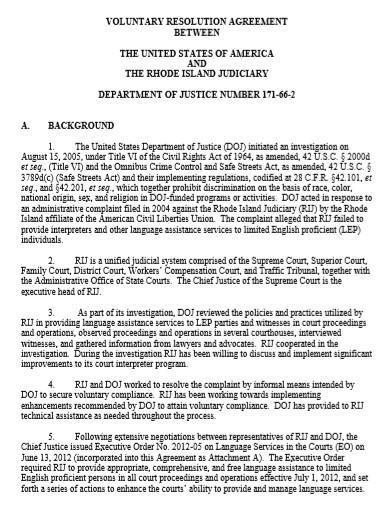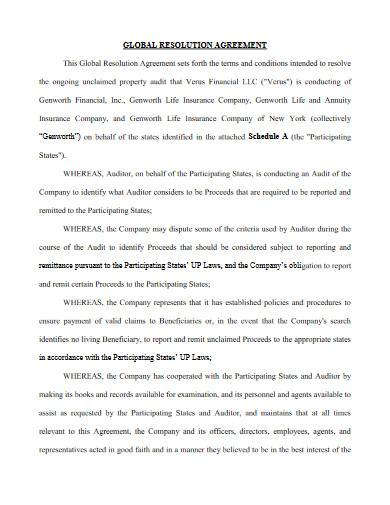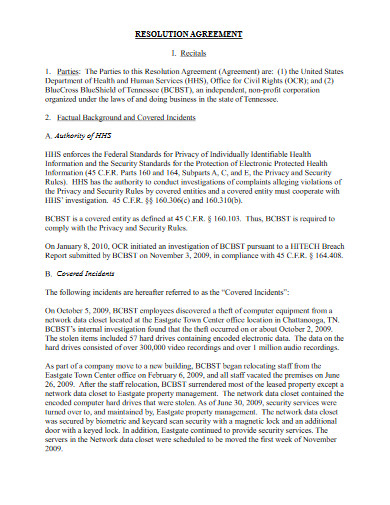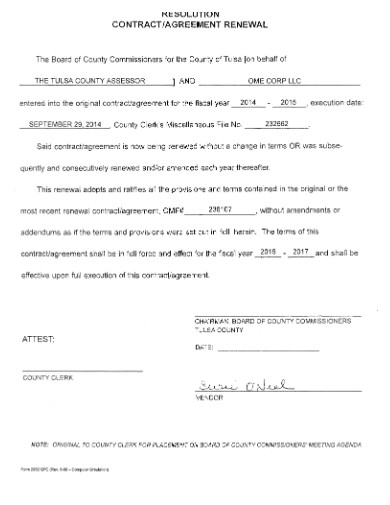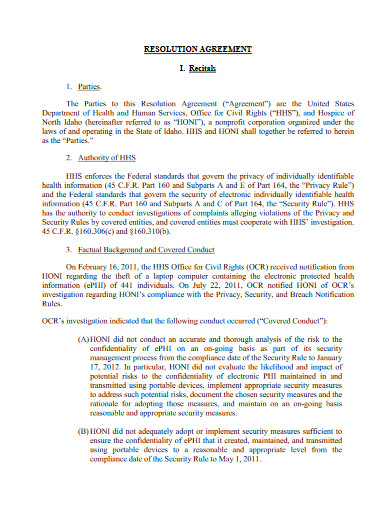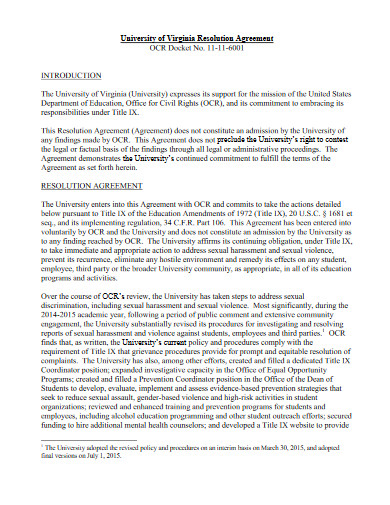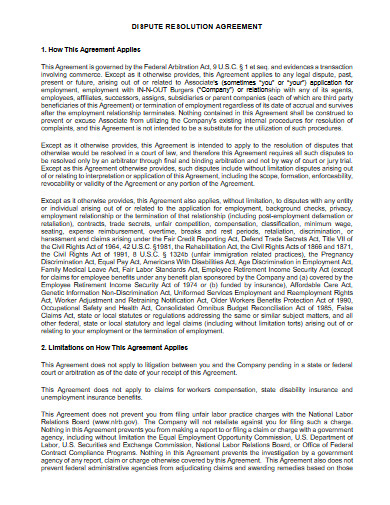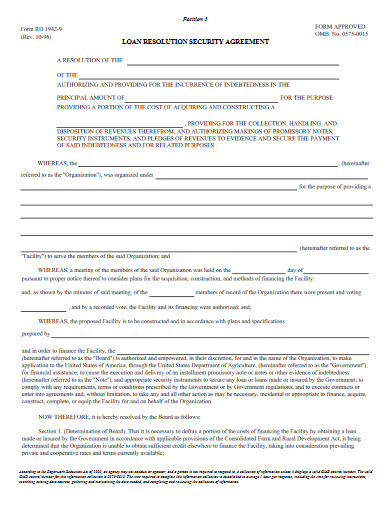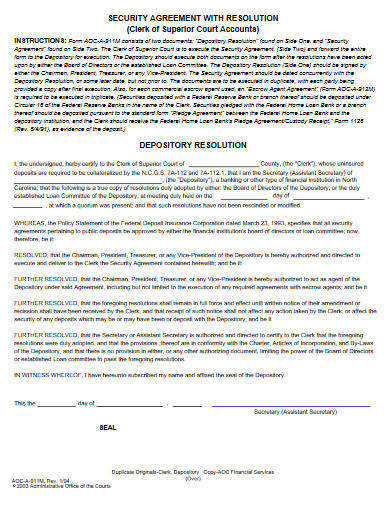10+ Resolution Agreement Examples
From time to time, business organizations encounter conflicts with their settlements. And as professionals, their respective boards have to perform their decision-making functions, especially when it comes to legal matters. They have to provide a written conflict resolution or dispute resolution document that details the mutual termination, cancellation, or closure of their troubled contracts and agreements. This particular document is commonly known as a resolution agreement. It is very much applicable in instances like employment separation, end of contract, corporation dissolution, and confidentiality-related situations. If you wish to learn more about the document, take a look at our highly-relevant article and examples below!
10+ Resolution Agreement Examples
1. Voluntary Resolution Agreement
2. Global Resolution Agreement
3. Sample Resolution Agreement
4. Resolution Contract Agreement Renewal
5. Conflict Resolution Agreement
6. HIPAA Resolution Agreement
7. University Resolution Agreement
8. Alternative Dispute Resolution Agreement
9. Dispute Resolution Agreement
10. Loan Resolution Security Agreement
11. Security Agreement With Resolution
What Is a Resolution Agreement?
A resolution agreement is a legal document which two organizations produce to describe the adjudication of a certain dispute. According to the American Bar Association, it can also cater to other forms of disputes, such as environmental disputes, family, personal injury, housing, neighborhood, consumer, business, and employment. Moreover, this certain type of agreement can also serve two ways in meeting the much-needed rectification of business affairs. It can either go the traditional way where the involved parties entrust the outcome to the court or other institutions. Or, it can adopt the other dispute resolution processes, which provide cheaper, faster, and more manageable procedures.
The Different Types of Dispute Resolution Process
The dispute resolution process, which also goes by the name alternative dispute resolution, appropriate dispute resolution, or, ADR has three basic types of dispute resolution process. They include mediation, arbitration, and litigation.
1. Mediation – This is the process where a neutral third party assists disputants to resolve their discourse by themselves.
2. Arbitration – For this type of dispute resolution process, the neutral third party is in charge of giving the final verdict. But before deciding, the appointed arbiter takes insights from the disputant’s pieces of evidence and reasonings.
3. Litigation – This type of dispute resolution is common among disputants. This is when they resort to face off in the court and in front of a judge.
How To Create a Resolution Agreement
Creating a resolution agreement requires basic skills in writing contracts or agreements. Not only that, but you also need to know its standard document flow. To help you achieve those without going through so much hassle, we highly recommend you check out our standard-based outline below.
1. Present the Purpose
Start your resolution agreement by presenting the statement of purpose that clearly describes the document’s context. This section should include the basic information of the disputants, specifically the legal names and complete addresses. In addition, the exact date when the participants have signed the agreement must be written down. We’ve provided you with an example below.
“This resolution agreement intends to delineate the reconciliation between Company A, with business operation at 3918 Crowfield Road Gilbert, Arizona 85233, and Company B, with business operation at 4832 Hillside Street, Scottsdale, Arizona 85259, made effective today, August 26, 2020.”
2. Describe the Dispute
To fully understand why the agreement came to be, you have to put into writing the complete details of the disputants’ conflict. For this part, you have to indicate when and how the incidents happen. If the dispute has something to do with a breach of contract, you must point out which provision of the contract has been violated.
3. Detail the Terms and Conditions
After describing giving a brief history, you can now make a list of the terms and conditions. The most important subsection for this part is the corrective action plan. It should present the duties and responsibilities of each party to set things right in their business affair. Right after that, you must discuss when and how the two can unbind themselves from the obligations.
4. Specify Recompensation Points
Most of the disputes damage not just the credibility of one party, but also its financial aspect. Because of that, you must take into consideration the recompensation of such damages. For you to do so, you just have to gather the casualty’s property damage reports and other relevant damage reports. Once you have all the necessary documents collected, write down the total costs, the repayment schedule, and the payment mode.
5. Incorporate the Confidentiality Clause
The last thing you have to do in your resolution agreement is to make sure that all the sensitive pieces of information stay between the involved parties unless they provide authorization to another party. Needless to say, you have to create a non-disclosure agreement (NDA), data confidentiality agreement, or mutual confidentiality agreement in your document.
FAQs
What is a corporation dissolution?
A corporation dissolution is the undertaking where an organization terminates its corporate identity and existence. It is also referred to as voluntary dissolution. This undertaking has three types, including by agreement, compulsory dissolution, on the happening of certain contingencies, and by notice of partnership at will.
What is the difference between a dispute and a conflict?
According to the American politician John Burton, a dispute is a short-term dissent which involves debatable complications. On the other hand, Burton said that conflicts are non-negotiable problems that were long-established and can last for a long time.
Do I need a lawyer for a dispute resolution process?
It depends on what type of dispute resolution process you are involved in. In the process of litigation, the presence of an attorney is necessary.
In his book entitled The Entitlement Trap, business consultant and author Richard Eyre wrote, “Resolution, like responsibility, is a product of ownership, and kids can’t resolve a conflict until they figure out how they contributed to it.” It is true that a resolution can never be resolved without a clear understanding of the directives set by two organizations before they became disputants. This comprehension is necessary not just before the disputes have been made, but also after it was made. This is the very reason why the involved parties have to create a document that does not just protect them from further complications, but also remind them of what should be followed.



